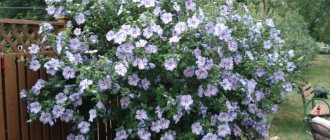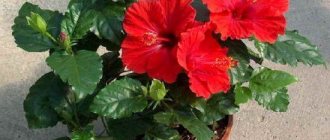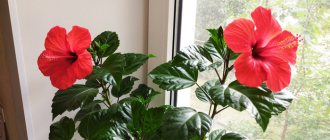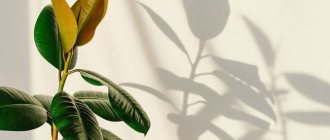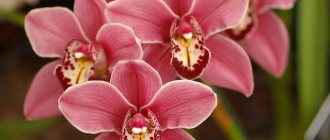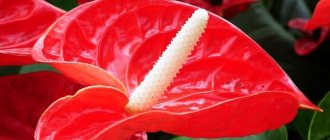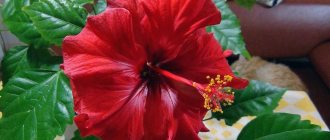Author: Galateya
11 October 2022 14:52
Community: Secrets and riddles
Tags: hibiscus Chinese rose beliefs why symbols death of the owner flowers
35255
9
In many apartments, on the floor, window sills or special stands you can often find a luxurious plant with large leaves and beautiful flowers. It is also used for office decoration. We are talking about hibiscus or, as it is also called, Chinese or Sudanese rose. But many are afraid to acquire this flower because of the belief that hibiscus is the flower of death.
Hibiscus (Chinese rose) - description
Hibiscus, also known as Chinese rose, is a popular crop among most gardeners. The plant is considered an excellent option for those who are just starting to garden and grow indoor flowers and flowers in the garden. A characteristic feature of the flower is its unpretentiousness and ease of cultivation. This species has many representatives, which are distinguished by the shape of flowers and leaf blades, dimensions, color, and a number of other criteria.
It all depends on the species; hibiscus can be either annual in the form of single flowers or perennial shrubs that can decorate any garden. In nature, the Chinese rose can reach 20 m in height and 3–5 m in width. A very important specific feature of the plant is considered to be resistance to the negative influences of nature, including sub-zero temperatures. In winter, hibiscus can tolerate frosts down to -20? C. The only thing you need is to organize a film shelter.
In nature, hibiscus reaches 20 m in height and 3–5 m in width.
Botanical description
According to the scientific classification, hibiscus belongs to the evergreen shrub plants of the Malvaceae family, which can be annual or perennial.
The plant has petiolate, incised leaves. The fruits are formed into a capsule, which breaks into 5 parts; inside it there are pubescent or smooth seeds in large quantities. The brightest and most beautiful part of the plant is the hibiscus flower (photos of various colors are shown below).
For growing at home in European countries, a greenhouse type of hibiscus called the Chinese rose (lat. Hibiscus rosa-sinensis) is used. The Malay Archipelago is considered its homeland and has flowers of different colors and shapes. Over the past 20 years, geneticists have been able to develop many new varieties of Chinese roses, which flower growers rightfully consider one of the main decorations of many home flower beds.
Hibiscus: origin and distribution
Researchers have discovered beautiful, colorful flowers in the tropical forests of Asia for the first time. In the wild, hibiscus grows as shrubs reaching three meters in height. The Chinese rose is also widespread in South America, especially in Argentina, where these flowers are usually grown in almost every home.
Hibiscus was brought to Europe only in the 18th century, where it became fashionable and was grown in greenhouses and homes. Despite the fact that many superstitions are attached to it, its care and colorful flowering evoke only positive reviews from gardeners. Why is hibiscus the flower of death? The answer to this question will be discussed below.
Care
Hibiscus flower: what kind of plant, description, how to grow
Water the plant moderately, making sure that the soil does not dry out. Mulching the tree trunk circle with crushed bark or perlite will help. Constantly keep the soil slightly moist during dry periods, otherwise the buds will not hold. Sprinkling in the evening will be beneficial.
Feed in early spring, applying complex fertilizers for flowers, which contain at least 16% nitrogen. In summer, flowers need potassium. In August and September they fertilize with potassium-phosphorus preparations. In October, water with 30-40 liters of water, mulch with humus, and hill up. In the regions of central Russia, young bushes are later covered with spruce branches or burlap and spunbond.
Water the plant moderately
After spring feeding, the hibiscus is pruned. It is necessary to remove the branches that grow inside the bush and those that are damaged. Young shoots will grow quickly. Then the plant is formed by cutting off the branches by 1/3. The bush will become more lush and by summer it will produce large flowers that form on the shoots of the current year.
Additional Information. After possible slight freezing, the hibiscus quickly recovers and grows shoots.
Indoor maintenance includes:
- regular watering and spraying of the plant;
- organizing a dormant period in winter with temperatures up to 14-16 °C;
- highlighting a place with bright diffused light.
Meaning in the culture of different nations
Hibiscus has a certain meaning in the culture of many peoples. Natural magic expert Ellen Dugan writes about its magical properties in her book “Magic in Your Garden. The magical properties of plants and ways to work with them.” Here's what you should know when purchasing a Chinese rose:
- In Haiti, hibiscus is a sacred flower. You will find his image in national symbols. The Chinese rose is woven into wreaths that are used to honor dear guests on the island.
- The national currency of Malaysia contains an image of a hibiscus, where the plant is also considered sacred.
- The Chinese believe that when a hibiscus bush blooms in a house, a happy wedding will soon be celebrated there.
- Brazilians wait for the Chinese rose to bloom with excitement, because this good sign announces the birth of children in the family.
- Indian brides decorate their hair with Chinese rose flowers before the wedding ceremony, as in India they are considered a symbol of innocence.
The rose bush lives for a very long time (up to 30 years), blooms for seven months a year, delighting the eye with bright colors.
Attitude to flowers in Europe
In general, the root of negative superstitions regarding hibiscus in Europe, since due to its scarlet color they began to associate it with death.
Allegedly, the petals are actively used by witches to prepare a potion that brings about the crown of celibacy. In European countries, the shrub is even called burnet, since it can supposedly provoke blood diseases (most likely this is again due to the color). There is also a widespread belief that a single woman who has a Chinese rose in her house will soon begin to enjoy unprecedented popularity with the opposite sex, but it will not be possible to create a serious permanent relationship while the pot of burnet is in the house.
Probably due to the ability of the Sudanese rose to draw energy from those around it, it is actively used to decorate hospitals, clinics and other medical institutions, where it feels great and blooms in lush colors. Naturally, this position is also not supported by any scientific facts.
Popular signs
- If a Chinese rose blooms during a period uncharacteristic for this process, then it is believed that someone in the house will soon die. To avoid this, the plant must be immediately disposed of, or, more precisely, burned.
- Hibiscus negatively affects the health and life of its owner. That is why it is not recommended to install a flower in the bedroom. It is believed that after the death of the owner of the plant, the Chinese rose blooms powerfully and profusely. This is explained by accumulated energy.
- If the flower has dropped all its leaves, this indicates that the residents of the house need to go to the hospital. Thus, hibiscus warns that someone in the household has health problems.
- The Chinese rose helps to attract men to unmarried girls. However, at the same time, the flower drives the male sex out of the house. This suggests that the girl can’t expect happiness.
- If hibiscus appears in a house where an established married couple lives, then the plant becomes a source of discord and unrest and, as a result, people will be unhappy. The “flower of death” is used to make a crown of celibacy. However, history is silent about who is doing this and how.
Why do omens not come true?
During the Soviet era, hibiscus (Chinese rose) was a common and popular houseplant and, most likely, it was the unpleasant moments associated with the flower that caused the bad omens. However, hibiscus continued to remain popular with many gardeners, despite beliefs and claims that the Chinese rose brings misfortune and harm.
Of course, we should not classify all the signs associated with hibiscus as folk, because most of them came to us from Europe, where it was widely believed that the Chinese rose brings misfortune, separates families and separates people.
Quite a large number of people say that hibiscus is the flower of death, why has no one died from it yet, and is it possible to throw out a Chinese rose if you already have one in your house? Let's check if this is true.
Some signs say that when the hibiscus blooms, illness or death will certainly befall the household, at the same time, an indoor rose pleases with its flowering, which is why people grow it at home.
If you believe other signs, the flowering of hibiscus in late autumn and early spring leads to illness or death of the owners. The Chinese rose blooms from late spring to autumn, also at the beginning of winter. It’s interesting that a Chinese rose at home is a bad omen, but this belief applies to all indoor plants, and it’s up to you to believe it or not.
The Chinese rose is also called an energy vampire, and many believe that hibiscus takes energy from its owners during flowering. There is another point of view: the Chinese rose absorbs negative energy and in return gives out positive energy when it blooms. By the way, hibiscus also received the second name “vampire” because of its bright scarlet blooms.
Signs associated with hibiscus
0
Source:
There are other signs among people associated with the Chinese rose, both positive and negative. The most common ones are:
- Growing this shrub at home can provoke a man to leave the family. For such a “superpower”, hibiscus even received a creative name - muzhegon;
- during flowering, albeit short-lived, quarrels, scandals, and clashes over trifles begin in the house;
- in its natural environment, the plant blooms from late spring until approximately October. If the buds bloom unexpectedly - in early spring or winter, this is a signal of the death of one of the family members;
- dry leaves and blackened buds are also an unkind sign, signaling changes of a negative nature.
The end of the white streak in life begins with the death of the hibiscus
Another superstition related to why the Chinese rose is the flower of death. Perhaps this is explained by the fact that the transience of flowering provokes the appearance of sad thoughts about the natural fading of the beauty of any living creature.
But it is worth remembering that this is the same biological process that occurs according to its own rules. One bud of an ordinary hibiscus usually blooms for no longer than one day. Fortunately, others come to replace it, and an adult plant produces several flowers at the same time. And if the right conditions are created, the hibiscus will bloom constantly.
Problems during cultivation
Like all ornamental crops, when growing Chinese roses, various difficulties and problems can be observed. Knowing their cause, you can adjust the care and improve the condition of the plant.
The most common problems:
- The buds that appear do not open, but fall off. The situation may be caused by a lack of moisture in the air and soil, a deficiency of nutrients coming from the soil, or low indoor air temperature.
- The lower leaves fall off and new ones begin to grow yellow in color. The problem is associated with a high content of chlorine and calcium in the soil, a lack of nitrogen and iron, and this also occurs when the air is dry or watered with too cold water.
- With a good lush crown, the plant does not want to bloom. The situation occurs due to excess nitrogen fertilization or insufficient light, high temperatures in the cold months (when kept in a warm room).
- Pinkish spots on the leaves usually appear when there is too much fertilizer or poor lighting.
Popular beliefs
There is a popular belief that the flowering of hibiscus is a very dangerous time for all household members. The flower spreads negative energy, drains vitality and health from people, and sows anger and irritation throughout the home. House occupants may become seriously ill or even die. It is believed that after sending a person to the next world, the plant begins to bloom especially abundantly and luxuriantly, since it has been imbued with the energy of the owner. It is said that this is the reason why hibiscus plants do so well in hospitals.
According to another version, danger threatens only if the Chinese rose blooms at the wrong time, for example, in winter or mid-summer. It is even recommended to burn such a “wrong” flower. The usual flowering period is from May to November.
The blackened leaves of the burnet (another creepy name for the plant) also warn the owners of an impending serious illness. Everyone living in the house needs an urgent health check. An alarming sign is if all the leaves have fallen off.
Fallen leaves - to a serious illness
Another sign that explains why the Chinese rose is the flower of death tells us that discarded leaves portend a serious illness or misfortune. It is not possible to refute or confirm this sign, since it was formed many generations ago. According to legend, without leaves, hibiscus does not receive the necessary energy and draws it from the people living next to it. At the same time, there is an opposite opinion, which is that a withering plant takes on the illnesses of family members, thereby protecting them.
In any case, all evergreen plants gradually renew their green mass by getting rid of leaves. There's nothing scary about it. Although if the growing leaves begin to turn yellow or black, then this is an alarm signal. It is necessary to examine the hibiscus for the presence of pests and, if necessary, take measures to treat it.
Any process can be explained from a scientific point of view, so you should not torment yourself with beliefs and signs. But if you are really tormented by premonitions and suspicions, then it is better to consult a doctor to either calm yourself down or prevent a terrible disease.
Associated with hibiscus flowering
The following beliefs are associated with the flowers of the plant:
- Hibiscus is believed to be a lover of negativity, which is why it grows well in hospital hallways and administrative offices. In fact, the flower develops where there is a lot of light and large windows.
- Some people claim that hibiscus blooms before the death of the one who grows this plant. However, those who have had a Chinese rose for many years refute this opinion. The plant does not contain toxic substances or toxins, and hibiscus tea is brewed from its flowers.
- Untimely flowering of a plant can lead to death. Girls of marriageable age should not be given hibiscus flowers; she may not realize her dream. Blooming hibiscus is considered a "husband".
Garden varieties
There are many types of garden hibiscus and most of them are very unpretentious. They can be planted even in a very dark place.
Species bred by breeders can be grown even in central Russia. However, in winter they will need to be covered with something or dug out of the ground.
Very often people confuse species such as Syrian and garden hibiscus, but this is not correct. Syriac is also commonly called “flower of love”, but scientifically it has the name tree-like.
The flowers of this hibiscus have several colors, but the main ones are white and lilac.
Garden hibiscus on the site
The main agrotechnical characteristics of garden hibiscus (Chinese rose) grown in open ground are as follows:
- Perennial unpretentious bush. In winter, the above-ground part dies off, new shoots appear in May
- Flowering begins in the second half of summer and continues for several weeks.
- With proper care, the size of flowers can reach 20-30 cm
- Garden hibiscus require plenty of sunlight and moisture.
- They winter well, but require little shelter for the winter (for example, you can pour a layer of earth 15-20 cm high on top)
- Reproduce by seeds, divisions, live bait
- Life period: up to 20 years
Illumination
Well-lit place (at least 6 hours of diffused sunlight per day)
Garden varieties of hibiscus delight the eye with large leaves and flowers that require a lot of moisture.
Watering is conventionally divided into two periods
spring/summer (high temperatures): stable water supply
During this period, it is important to prevent stagnation of water in the root ball, in order to avoid rotting of the roots. Winter (low temperatures, high air humidity): rare watering, only after the top layer of soil around the above-ground part of the plant has dried well. Spraying
Spraying
Top dressing
spring/summer: 1 time every 2 weeks, especially after the appearance of flower buds. Liquid fertilizers for flowering tropical plants are used as fertilizing. Organic fertilizers are also popular among experienced gardeners.
during the rest period the plant does not need additional feeding
Hibiscus are very fond of acidified soil (in this they are very close to roses). The planting site is prepared in the autumn
1. Prepare a soil dressing mixture. For a garden bed with an area of 1 m² you will need
- granulated superphosphate - 40 g
- river sand - 5 l
- cow humus - 5 l
- yellow clay (carefully dried and crushed) - 5 l
- high-moor peat – 5 l
2. Spread the nutrient mixture evenly over the area previously cleared of weeds.
3. Dig up the bed
Trimming
The procedure is performed only for an adult plant (age - over 4 years)
Types of possible trimmings
To stimulate flowering
hygienic (thinning)
For bush shaping
Performed after flowering, no later than September
All branches/shoots are cut off. This is done extremely rarely if the plant is in danger of dying.
A fading flower takes away all troubles
Many people believe that sick pets and fading flowers of indoor plants take on the illness of one of the family members or ward off trouble from the home.
People have always attached great importance to the mystical connection between man and plant. This is reflected in many legends and traditions that have survived to this day. For example, in Western Europe, it has long been believed that young trees growing on the roof protect the house from thieves and lightning. Someone is sure that a blooming hibiscus shares all the hardships with a person.
In Belgrade they love it when the hibiscus bush blooms in front of the house
Explanations of scientists
According to biologists, the unusual behavior of the plant (violent flowering and wilting) is evidence of unfavorable changes in the environment and microclimate in the room where the hibiscus is located. It can be caused by the appearance of mold from dampness or drying out due to high dry air, harmful emissions from nearby industrial enterprises.
Scientists also explain the myth that a withering plant becomes a vampire by natural causes. The stems and leaves of hibiscus have high absorbent properties, which is why they literally absorb any harmful (even radioactive) air particles. Therefore, the unexpected fall of green mass indicates a critical amount of harmful radiation. Therefore, instead of getting rid of a diseased plant, it is better to find the cause of the unfavorable conditions and begin to eliminate it.
Biologists do not advise sounding the alarm about the fall of several leaves, since this evergreen plant is capable of regularly renewing its crown, and this is a natural process inherent in nature itself. So the answer to the question of whether it is true that hibiscus is the flower of death can be absolutely answered - no. It is better to find out what beneficial properties such a plant has.
Is it possible to plant hibiscus in the garden?
Hibiscus came to us from afar, and our climate is not very suitable for it. But, thanks to breeders, varieties have been developed that are suitable for our latitudes. These specimens do not exceed three meters in height and can withstand frosts of up to 30 degrees.
Of course, in order to survive the winter, the plant will need to be helped - either by covering it well or bringing it into the house - after all, it’s a rare winter in Russia without the temperature dropping below thirty degrees.
There are several types of hibiscus that can be grown here, but the principle of care is the same for all. First, you need to choose a suitable location. The plant should be protected from bright sun. There should also be no threat of strong winds. Secondly, the soil should be quite loose and nutritious. Timely watering is necessary as the soil dries out.
Different species have their own care requirements. And a kind of pruning, and weeding, and mulching. But any species requires insulation for the winter, so don’t forget to try in the fall.
Chinese rose can be grown from seeds and cuttings. It is better to sow seeds in mid-winter. Do not forget to spray future bushes in a timely manner. They can be planted in open ground only when the threat of frost has passed.
When cutting, you need to remove almost all the leaves from the shoot and place it in water. When fairly long roots appear, you can plant the hibiscus in a pot with peat, from where you can transplant the bush into open ground when the plant gets stronger.
And don’t forget, young plants do not tolerate frosts so well, so insulation measures will have to be thought out especially carefully in the first year.
Video on how to plant and care for hibiscus
Types of hibiscus, when and how to plant it correctly. Flower propagation by seeds and cuttings. Pests and diseases of hibiscus, effective methods of controlling them. Join the viewing!
Hibiscus is a good solution for lovers of spectacular indoor plants and experimental gardeners who are not afraid of possible difficulties. By providing good care for the flower and placing it in an open, illuminated place, you will provide home comfort, enjoy long-term flowering and get a real “green doctor” for the air in your room! All the best on your journey of growing hibiscus!
According to feng shui
Chinese rose influences the movement of Qi energy, which is responsible for people's health. Feng Shui experts recommend growing a flower with white inflorescences for hot-tempered people. The element of fire predominates in the plant. The flower extinguishes outbursts of anger, suppresses anxiety and nervousness.
If you place a pot of the plant in your office, hibiscus will help concentrate your energy.
Beneficial properties of hibiscus for humans
People from the East do not consider hibiscus a flower of death, since it carries positive energy and enriches everyone around it with it. A blossoming Chinese rose is somewhat reminiscent of a flame of fire, which brings courage, activity and strength. From the point of view of Feng Shui, the Chinese rose attracts goodness into the house, protects residents and absorbs bad energy.
From flowers you can prepare medicinal decoctions that relieve ailments, give the skin elasticity and youth, and also cure ulcers and boils. Tea prepared from this flower saturates the body with anthocides. This leads to normalization of pressure, strengthening of vessel walls, and restoration of gastrointestinal functions.
IMPORTANT If you take hot tea, a sharp increase in blood pressure occurs, while cold tea reduces blood pressure.
Tea also strengthens the immune system, cleanses the body of toxins and waste, and has antibacterial and bactericidal properties. Anyone can grow this flower, since there is no allergy from it, and the nectar of the flower is a good aphrodisiac that will not only decorate the bedroom, but also strengthen family relationships.
Healing properties
The use of this beautiful flower for medicinal purposes contradicts the statement that the Chinese rose is the flower of death. Due to its beneficial properties, it:
- helps improve appetite and has a good effect on well-being;
- has a beneficial effect on the cardiovascular system;
- has a positive effect on blood pressure, reducing it;
- has antibacterial properties (its seeds are also used in making coffee and seasonings).
Chinese rose tea saturates the body with anthocides, strengthens the immune system, and activates choleretic and antispasmodic effects.
The plant contains flavonoids that help eliminate excess harmful substances that are formed due to improper metabolism. And hibiscus petals help the liver and gallbladder work. It is the basis of hibiscus tea, which has antibacterial properties.
Interesting facts about hibiscus
Hibiscus comes in different types. There are hybrid, marsh, Syrian, splayed and other varieties. Flowers can also be not only red, but also other colors - white, blue, yellow. You can grow a Chinese rose not only in a pot, but also in a country house or garden: a special garden variety has been bred for this. In some countries, in addition to tea, dried Chinese rose petals are used to make medicine, food coloring and hair dye. Sour varieties are quite capable of replacing spinach: they are not inferior to it in taste, contain a lot of carotene and B vitamins. Edible rose or okra was already known in Egypt more than 800 years ago: the unripe seed pods of the plant were used to prepare delicacies. And in Hawaii, hibiscus even earned the honorary title of “flower of beautiful women” and is a kind of national treasure. Decorate your home with this amazing plant and don’t be afraid of superstitions. A hibiscus grown with love will delight the eye, give positivity and the opportunity to enjoy the creation of a brilliant Creator - nature itself.
What is hibiscus, what flower is called hibiscus?
The decorative flower hibiscus, or Chinese (Sudanese) rose, belongs to the mallow family. The shrub is native to China and northern Indochina. Due to its unpretentiousness, the plant has become widespread in countries with subtropical and tropical climates.
The word “hibiscus” means “ibis bird” (translation from Greek), hinting at the similarity of large inflorescences with a bird. A plant in spacious rooms can acquire enormous dimensions if it is not pruned, then each branch can produce a beautiful flower, while the decorative effect of the bush disappears.
The inflorescences come in red, pink, yellow shades, the type is double or regular, like a bell. The flowering period of any of them is two days. Fallen flowers can be used to brew special medicinal tea - hibiscus.
How to get rid of hibiscus, is it worth it?
There are several reasons for getting rid of a plant:
- belief in omens and superstitions;
- loss of decorativeness of the bush;
- cessation of flowering.
It’s very easy to get rid of the Sudanese rose – take it to a winter garden or hospital. You are allowed to give symbols to a friend who does not believe in bad things. Some ruthless people simply throw out the sprout after it has lost its decorative effect and stopped blooming. People who have bad omens about the Sudanese rose are advised to burn it along with the pot, while taking the plant far from home. Quite a barbaric method.
Bright and colorful "flower of life"
Correcting mistakes and following simple care rules allows gardeners to successfully grow this plant at home. That’s why many of them leave positive reviews about the “flower of death” hibiscus on the websites of ornamental plant lovers. Why it was called that was described above.
Scientists advise not to believe in bad omens and stories about this beautiful flower. After all, all problems with its flowering or wilting are explained by completely natural reasons. Proper care, watering, pruning and fertilizing will prevent the death of the flower and not worry about the fate of its owner in the future.



